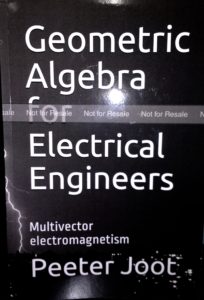Here’s a fun congratulatory email that I received today for my Geometric Algebra for Electrical Engineers book
Peeter ..
I had to email to congratulate you on your geometric algebra book. Like yourself, when I came across it, I was totally blown away and your book, being written from the position of a discoverer rather than an expert, answers most of the questions I was confronted by when reading Doran and Lasenby’s book.
You’re a C++ programmer and from my perspective, when using natural world math, you are constructing a representation of a problem (like code does) except many physicists do not recognize this. They’re doing physics with COBOL (or C with classes!).
congratulations
.. Reader
I couldn’t resist pointing out the irony of his COBOL comment, as my work at LzLabs is now heavily focused on COBOL (and PL/I) compilers and compiler runtimes. You could say that my work, at work or at play, is all an attempt to transition people away from the evils of legacy COBOL.
For reference the Doran and Lasenby book is phenomenal work, but it is really hard material. To attempt to read this, you’ll need a thorough understanding of electromagnetism, relativity, tensor algebra, quantum mechanics, advanced classical mechanics, and field theory. I’m still working on this book, and it’s probably been 12 years since I bought it. I managed to teach myself some of this material as I went, but also took most of the 4th year UofT undergrad physics courses (and some grad courses) to fill in some of the gaps.
When I titled my book, I included “for Electrical Engineers” in the title. That titling choice was somewhat derivative, as there were already geometric algebra books “for physicists”, and “for computer science“. However, I thought it was also good shorthand for the prerequisites required for the book as “for Electrical Engineers” seemed to be good shorthand for “for a student that has seen electromagnetism in its div, grad, curl form, and doesn’t know special relativity, field theory, differential forms, tensor algebra, or other topics from more advanced physics.”
The relativistic presentation of electromagnetism in Doran and Lasenby, using the Dirac algebra (aka Space Time Algebra (STA)), is much more beautiful than the form that I have used in my book. However, I was hoping to present the subject in a way that was accessible, and provided a stepping stone for the STA approach when the reader was ready to tackle a next interval of the “learning curve.”
